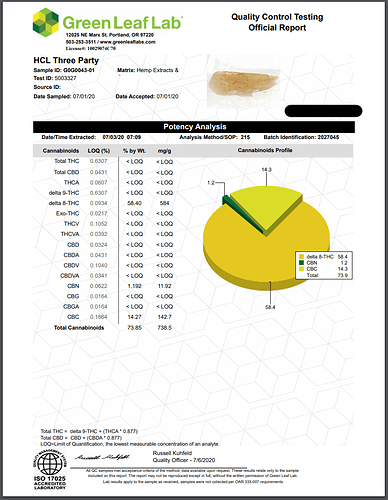This ![]()
4.9% D9? Yep that’s more than a traffic ticket when crossing state lines ![]()
Sell that in a cart? You jut invited the DEA to Big Bad Wolf your door down and shoot your dog.

More so the “95% water clear” testing at 75% known cannabanoids (and 25% who knows what)
@CBDOKIE Any rebuttal?
He just got me as well ![]()
To be fair scientists have been treating themselves as the guinea pig for centuries.
I do agree with you though. It’s not smart. But hey people can take their own risks
Do whatever the hell you want to your own body.
Using non-consenting strangers’ bodies as ones testing ground for shoddy labwork; is morally reprehensible. It can have grave consequences for individuals and our industry.
You received the same COA results as the poster above?
worse, and confusingly so
Got my result back from GreenLeaf. I asked them for the raw machine readout because the LOQ d9 is strange compared to the other COA, but % wise it’s fairly similar
I wonder what the rest is?
If you’ve ever talked to a lab and how they determine results, it’s not very far off from a monkey putting a stencil over the graph and seeing if the peaks fit. Yes, it’s more complicated than that… but asking them to interpret something that has a slightly odd peak is asking a lot.
I assume the rest might be for a large part the intermediate between d9 and d8, plus little some d8-thcv, plus a series of trace compounds.
@pdxcanna, was this from isolate ? What method ?
It still surprises me to see cbc/d10 in such mix, so far in all the tests I did, I haven’t seen anything in this region.
Damn I’m getting better results on first pass from converted crude…
I was told it was from isolate, you’d have to verify the process with CBDokie though
oh yes
Organic cultivation and mechanical seperation for the win.
If that is the separation of their reference standards in the second graph I would use another lab that can get those peaks further apart.
I dont know their method but it looks like they are trying to get these tests down to a shorter elution time and by doing that their peaks are to close together. Which is probably fine for the majority of the products they run which only have d9 and no d8 or d10
Our in house method elutes d9 at 9.5 minutes and cbc around 14 minutes. We have separation of d8 but havent ran it in a while so i dont remember the retention time but know there is a clear separation of peaks.
@thesk8midget I was talking with a good buddy of mine last night about a method to potentially space them out farther… method would require a 36 min run time

